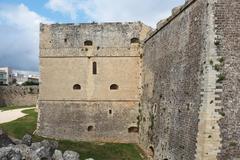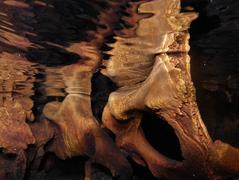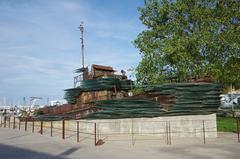Grotta Sfondata Visiting Hours, Tickets, and Travel Guide: Otranto Historical Sites
Date: 14/06/2025
Introduction
Grotta Sfondata, also known as the “Collapsed Cave,” is one of the most striking natural attractions along Italy’s Adriatic coastline near Otranto, in the Apulia region. Its dramatic geological formation—a large chamber with a collapsed roof—allows sunlight to flood the turquoise waters and rugged limestone, creating an unforgettable visual spectacle. This guide provides a detailed overview of Grotta Sfondata’s history, cultural significance, visiting hours, ticketing, accessibility, travel tips, and its integration with Otranto’s rich historical landscape.
For up-to-date information and travel resources, consult official regional sites and trusted tour providers (visit.puglia.it, Beautiful Puglia, Evendo).
Table of Contents
- Introduction
- Geological Features and Formation
- Historical and Cultural Context
- Environmental Importance
- Visitor Information
- Practical Travel Tips
- Connection to Otranto’s Historical Sites
- Nearby Attractions
- Guided Tours and Excursions
- Frequently Asked Questions (FAQ)
- Environmental Stewardship and Responsible Tourism
- Visuals and Maps
- Summary Table: Key Logistics
- Conclusion & Call to Action
- References
Geological Features and Formation
Grotta Sfondata is a prime example of karstic coastal geomorphology. Over millennia, acidic rainwater and the erosive action of the Adriatic Sea dissolved the region’s limestone cliffs, eventually causing the cave’s vaulted ceiling to collapse. The result is a natural skylight—approximately 30 meters wide—illuminating the cave’s interior and its crystal-clear waters (Evendo). The interplay of sunlight, water, and limestone produces vibrant colors that shift throughout the day, making it a favorite destination for photographers and nature enthusiasts.
The cave is accessible mainly by boat, kayak, or via scenic coastal trails, and features a natural pool connected to the sea through submerged tunnels.
Historical and Cultural Context
While Grotta Sfondata itself does not contain direct evidence of ancient habitation, the surrounding coastline of Otranto is steeped in historical significance. Otranto has been an important port since Roman times, with influences from Byzantine, Norman, and Aragonese periods. Local legends and the proximity to other notable caves—like Grotta dei Cervi, known for Neolithic rock art—add to the cultural tapestry of the region (visit.puglia.it, winalist.com).
Visiting Grotta Sfondata provides a natural complement to exploring Otranto’s historic center, which features architectural treasures such as the Otranto Cathedral and Aragonese Castle.
Environmental Importance
Grotta Sfondata lies within the Otranto-Leuca Natural Park, a protected area that preserves rare Mediterranean flora and fauna. The marine environment supports a variety of species, including sea bream, octopus, and vibrant seagrass beds, while the surrounding cliffs are home to orchids, seabirds, and wild herbs (visit.puglia.it, Evendo).
The cave’s open ceiling creates a unique microclimate and sensory experience—sunlight filters through, sounds of waves echo, and the scent of wild herbs fills the air.
Visitor Information
Visiting Hours
Grotta Sfondata is a natural, unregulated site accessible year-round. The best time to visit is from April to October, particularly between 8:00 AM and sunset when natural light is optimal. Sea and weather conditions can affect accessibility, so always check local forecasts before planning your visit.
Ticketing and Booking
There is no entrance fee for Grotta Sfondata itself. Access is free, whether you arrive on foot or by sea. However, most visitors reach the cave via guided boat or kayak tours, which generally cost €15–€40 per person, depending on the operator and duration. Advance booking is highly recommended in peak season (Beautiful Puglia, salentogiteinbarca.it).
Getting There
- By Boat/Kayak: Depart from Otranto’s harbor or nearby beaches; several local operators include Grotta Sfondata in their coastal excursions.
- On Foot/Bicycle: A scenic coastal path (2–3 km from Otranto’s center) leads to the cave area—sturdy footwear is advised.
- By Car: Park on Otranto’s outskirts and walk the final stretch.
- By Public Transit: Take a train or bus to Otranto, then walk or use a local bus toward the coast. Bus lines 113.01, 212.1, and 86.01 serve the area (Moovit).
Accessibility
Due to rocky, uneven terrain and access by water, Grotta Sfondata is not suitable for wheelchairs or those with limited mobility. Families with young children should exercise caution near cliff edges.
Practical Travel Tips
- What to Bring: Sturdy shoes, swimwear, towel, sun protection, water, snacks, and a camera.
- Best Time: Visit in the morning or late afternoon for the best light and fewer crowds.
- Swimming & Snorkeling: Allowed and popular, but be mindful of marine habitats.
- No Facilities: Bring all necessities—there are no commercial services at the cave.
Connection to Otranto’s Historical Sites
Grotta Sfondata is ideally combined with a visit to Otranto’s historic landmarks:
- Otranto Cathedral: Renowned for its mosaic floor.
- Aragonese Castle: A fortress with panoramic views.
- Grotta dei Cervi: A nearby cave with prehistoric rock art.
- Baia dei Turchi: A popular local beach.
Traditional masserie (farmhouses) and local restaurants offer authentic Salento cuisine nearby (visit.puglia.it).
Guided Tours and Excursions
Several operators provide guided boat tours that include Grotta Sfondata and other coastal highlights. These tours often feature commentary on the region’s geology, ecology, and maritime history. Booking in advance is recommended, especially during the high season (salentogiteinbarca.it, Evendo).
Environmental Stewardship and Responsible Tourism
To protect Grotta Sfondata’s pristine environment:
- Practice Leave No Trace principles.
- Do not litter or disturb wildlife.
- Avoid removing rocks, plants, or marine life.
- Participate in local conservation efforts and respect community guidelines (Evendo).
Frequently Asked Questions (FAQ)
Q: What are Grotta Sfondata’s visiting hours?
A: The cave is accessible from early morning until sunset year-round, with best conditions April–October.
Q: Is there an entrance fee?
A: No, access to the cave is free. Guided tours and boat excursions may have fees.
Q: Is the cave accessible for people with disabilities?
A: Due to uneven terrain and sea access, the cave is not suitable for those with limited mobility.
Q: How do I get there?
A: By boat, kayak, on foot via the coastal path, or by bicycle. Public transit brings you to Otranto, from where you can proceed on foot or by local bus.
Q: Are there facilities at Grotta Sfondata?
A: No facilities are available; bring your own water, snacks, and sun protection.
Q: Can I swim or snorkel?
A: Yes, swimming and snorkeling are popular activities, but respect the marine environment.
Summary Table: Key Logistics
| Mode of Access | Details | Estimated Time | Notes |
|---|---|---|---|
| By Air | Brindisi Airport (BDS) → Otranto by bus/train/taxi | 1.5–2 hours | Closest major airport |
| By Train | Lecce → Maglie → Otranto (L7 line) | 1 hr 20 min | Check seasonal schedules |
| By Bus | Lecce/Brindisi/Gallipoli → Otranto (lines 113.01, 212.1, 86.01) | 45 min–2 hours | Direct and transfer options |
| By Car | Lecce → Otranto (42 km); Brindisi → Otranto (90 km) | 30 min–1 hour | Park outside historic center |
| On Foot/Bike | Otranto center → Grotta Sfondata (coastal path, 2–3 km) | 30–45 min walk | Scenic, rocky path |
| By Boat Tour | Otranto port → Grotta Sfondata | Varies | Book in advance during high season |
Visuals and Maps
[Insert high-quality images of Grotta Sfondata’s skylight, turquoise waters, the coastal walking path, and Otranto’s historical sites. Include descriptive alt text such as “Grotta Sfondata visiting hours” and “Otranto historical sites.”]
[Embed an interactive map showing the location of Grotta Sfondata, Otranto’s transport hubs, and major nearby attractions.]
Conclusion & Call to Action
Grotta Sfondata is a natural masterpiece that seamlessly blends geological wonder, ecological diversity, and cultural heritage. Its proximity to Otranto’s historic sites makes it an essential stop for any traveler seeking both adventure and immersion in Italy’s rich past. Plan your visit for April–October, book guided tours if desired, and always respect the environment.
To enhance your travel experience, download the Audiala app for up-to-date navigation, real-time transit updates, and exclusive local tips. Explore our other posts on Puglia’s hidden gems and follow us on social media for the latest updates. Your unforgettable Adriatic adventure starts here!


